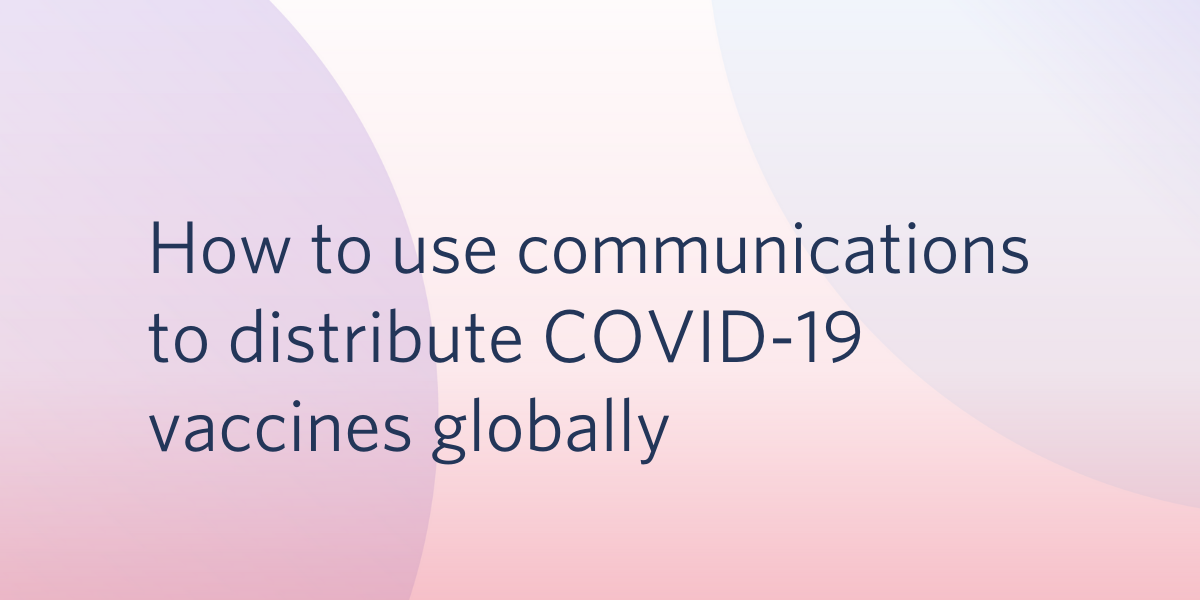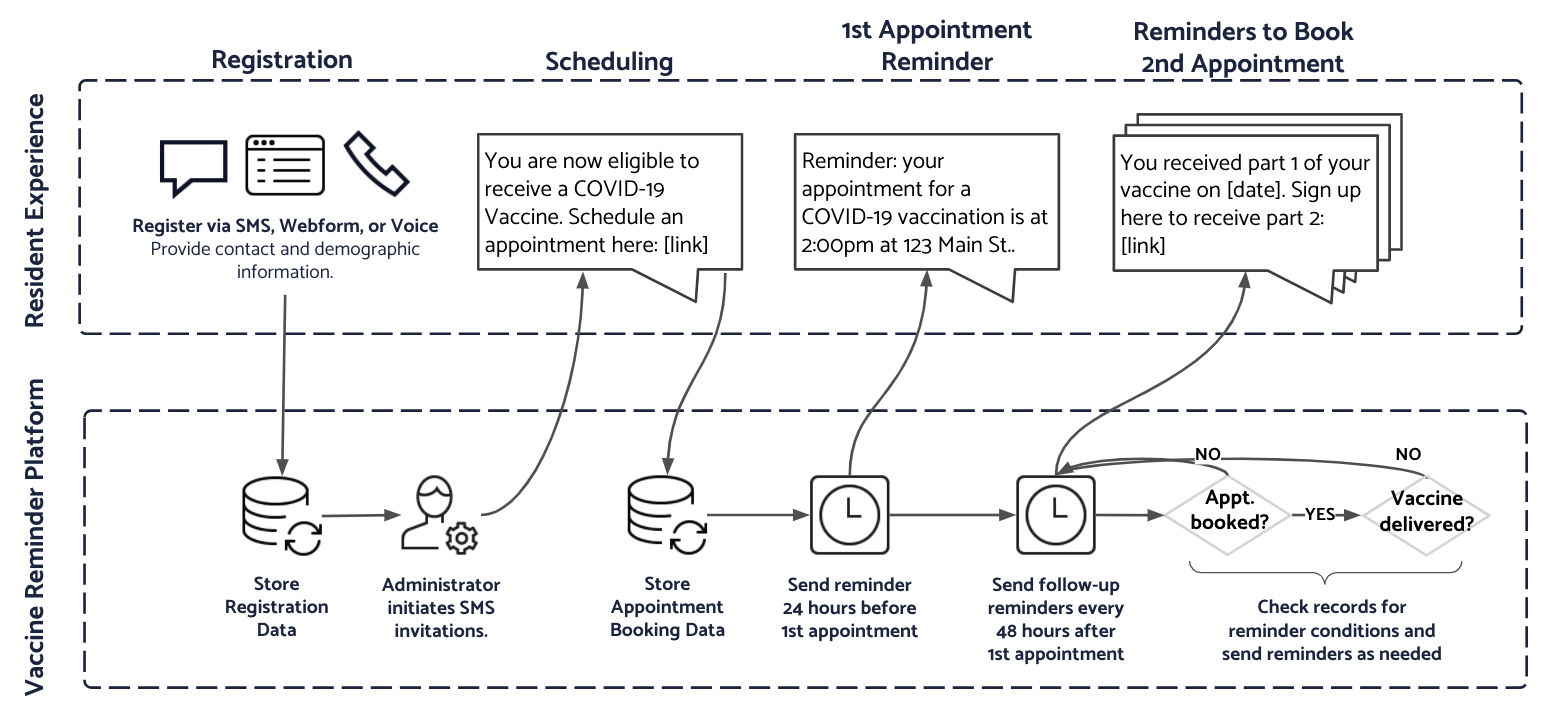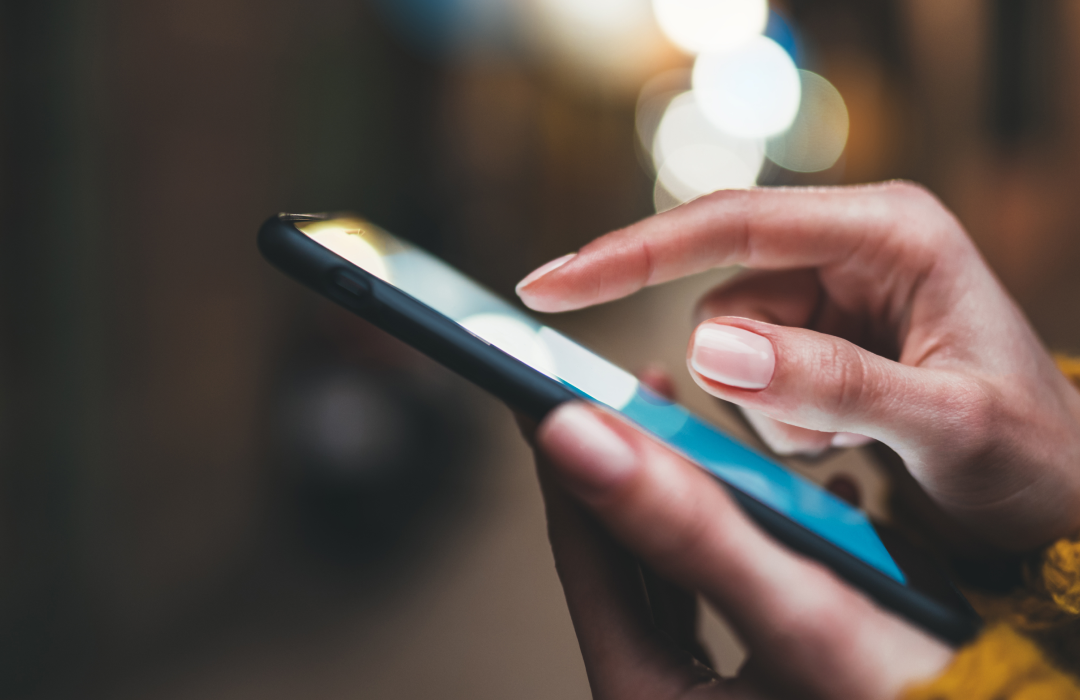How to use communications to distribute COVID-19 vaccines globally
Time to read: 7 minutes

As countries race to vaccinate residents for COVID-19, communications will play a critical role in ensuring effective, equitable vaccine dissemination. According to the U.S. Centers for Disease Control and Prevention (CDC), “[r]eaching intended vaccine recipients is essential to achieving desired levels of COVID-19 vaccination coverage.”
We’ve identified five key areas where communications and digital engagement can help public agencies, healthcare providers, pharmacies, employers, community organizations, and all public health stakeholders administer vaccine delivery. These areas are: public information and engagement, enrollment and registration, appointment coordination, monitoring vaccine effectiveness, and distribution logistics.
In particular, digital communications can promote vaccine effectiveness by helping patients to ensure they receive their second dose.
If you’re working on vaccine administration, Twilio is here to help. Together, we can now help ensure that everyone can get access to this vital vaccine.
Communication solutions for vaccines
We want to help you address the overarching challenges in rolling out vaccination programs, including public engagement, speed to market, scalability, employee and public safety, and equitable distribution. The following five use cases provide frameworks for building communications for vaccine administration.
We will keep this post up to date with new resources to help you build solutions to help people get vaccinated. Please contact us with any questions or to see how Twilio can help you and your organization build the right solution for your vaccination program.
Provide accurate vaccine information to the public
Public health stakeholders need to provide clear, accurate information about vaccination effectiveness and availability. Public information must be both broadly distributed and able to reach specific population segments across a wide variety of communications media and languages, whether the intended audience has access to TV, internet, a smartphone, or landline.
Additionally, this information must reach people who are eligible to receive a vaccination and dispel false information that could negatively influence vaccine use. Due to the fact that there is varying trust among the public in messages and messengers related to COVID-19, public information should be personalized for the intended audience.
Broadly used communication channels like email, SMS, voice, and WhatsApp are critical avenues to reaching and engaging people in order to provide the most up to date vaccine information. If you have a directory of patients or constituents you need to contact quickly, these channels can enable you to engage people where they are, whether that is their mobile device or computer.
We anticipate that many people will have questions about vaccine safety and availability. Informational hotlines can also serve a crucial role in providing up to date answers to constituent questions. Twilio Flex can enable your staff to rapidly intake, route, and respond to inbound inquiries, whether they are staffed in an office or working from home.
Until vaccinated, employees and volunteers are susceptible to contracting COVID-19. Digital communications can help ensure employee safety by enabling them to communicate with constituents from anywhere.
Resources to get started:
- COVID-19 Field Guide for Mass Notifications
- Build a chatbot for COVID-19 related FAQs
- Voice alerting with Twilio <Say> docs
- Communication preferences by generation article
Help people to sign up for a vaccine appointment
Demand will outstrip supply for the vaccine for at least several months. During the initial rollout and into scaled vaccine delivery, health professionals need scalable solutions to enable people to sign up for a vaccine, and then prioritize these requests based on eligibility, such as health personnel, essential workers, and high risk populations. As vaccine supply increases, communications must then scale to the size of entire city, state, and country populations while ensuring that distribution is managed equitably.
SMS bots, webchat, and IVRs can enable people to input relevant information that will enable you to determine eligibility for vaccination at each phase of the vaccine rollout. Then, you can integrate this information into your system of record and tag vaccine requests according to priority and vaccine availability. This way, you can ensure that essential workers and at-risk populations receive access quickly, and then automatically notify people when they are eligible to receive the vaccine.
Providers may want to consider a tool such as Twilio Lookup in order to automatically gather contextual information about inbound requests, such as whether a phone number is a landline or mobile phone, in order to determine the appropriate channel for follow up.
To help guard against fraud, a multifactor authentication service like Verify can help you ensure your constituents’ identity. This will be especially important during early phases in vaccine deployment when demand outstrips supply.
Resources to get started:
- Create self-service experiences with IVRs and Chatbots
- Deploy an IVR with Python, Django, and Twilio
- Build an SMS chatbot with Python, Flask, and Twilio
- Build a WhatsApp chatbot in PHP
Coordinate vaccine appointments and send reminders
Vaccinating people for COVID-19 presents three coincident challenges. First, the sheer scale of administration — the entire global population — necessitates appointment scheduling that scales accordingly. Automating scheduling through mobile messaging and IVRs can reduce administrative burdens for staff.
Second, COVID-19 currently approved vaccines require two doses, 21 or 28 days apart, in order to provide maximum protection against the virus. For this reason, appointment reminders are especially important to ensure that people follow up for their second inoculation. SMS and voice notifications can help remind patients when, where, and how to reach their appointments.
In some cases, patients will require additional support. Using Twilio’s suite of contact center tools, staff can manage inbound questions about scheduling or transportation, or reach out proactively to patients to ensure they can attend upcoming appointments.
Lastly, high volume appointments risk crowding outside of and within medical facilities. Creating virtual “waiting rooms” using video, voice, and SMS can help ensure that people remain socially distant until their designated appointment, keeping themselves and others at lower risk of exposure to COVID-19.
Resources to get started:
- Eliminate patient no shows once and for all blog post
- How to build appointment reminders developer guide
- Building appointment reminders developer tutorial
- Building a telemedicine waiting room with Twilio Video
- SMS and MMS notifications tutorial
Track vaccine effectiveness and patient health
As vaccines are deployed across populations, it will be important to ensure vaccine efficacy and monitor for any adverse health outcomes among vaccinated individuals. Using a bot or outbound IVR, you can follow up with patients through automated SMS and voice surveys after someone receives a vaccination in order to track and analyze patient response. These surveys can be integrated into many different systems of record, including REDCap, to assess patient outcomes from individual to population scales.
For personalized evaluations and symptom diagnosis in telehealth use cases, Twilio Video enables health professionals to connect directly with their patients remotely in order to assess side effects, allergic reactions, or other adverse health outcomes after receiving the COVID-19 vaccine.
Resources to get started:
- Conducting Health Surveys using REDCap and Twilio
- Create a COVID-19 data tracking SMS bot in PHP
- Deploy your own video collaboration app in five minutes or less
- Create a Video Conference App using Laravel, PHP, and Vue.js
Manage vaccine distribution logistics
COVID-19 vaccines are temperature-sensitive. Careful temperature monitoring during transit and storage can minimize the risk of inventory loss and reduced vaccine effectiveness.
Wireless-enabled temperature sensors can provide real time monitoring to ensure that supplies are kept at the appropriate temperature. Wireless tracking will enable organizations to manage inventory through distribution networks across air and truck deliveries, ensuring that shipments arrive safely and quickly. With this tracking, pharmacies, hospitals, workplaces, and other caregiving entities can monitor supplies to ensure they keep enough doses on hand for both the first and second inoculations.
Communications are often needed throughout the distribution network as well, and communication channels may vary across shipping, warehouse, and clinical staff. Situations like this require seamless connections among staff, and Twilio Conversations and Flex can enable staff to remotely communicate with delivery and storage personnel across communication channels, to ensure that vaccine shipments reach their destination safely and on time.
For example, a clinician could chat into a central warehouse facility to check on supplies using webchat. The agent at the warehouse might need to send a text message to a driver en route to the warehouse in order to determine when the next shipment of vaccines is arriving. That agent could then add the driver into the conversation, thus connecting various parties across communication channels in real time using a single conversation thread. This way, the clinician gets the information they need about vaccine availability fast, allowing them to focus on serving patients without delay.
Resources to get started:
- Build a "smart container app" to monitor food shipments with NB-IoT, Node and Pusher
- Extending the Twilio Developer Kit for Broadband IoT
A scalable solution for vaccine appointments
Bringing this all together, consider the following workflow for managing vaccine appointments. This is just one example, and is designed to help envisage how you can automate each stage of the vaccine administration process in order to serve more people, more effectively.
In this diagram, a resident first registers for the vaccine. When they become eligible, an administrator can send an invitation to schedule an appointment via SMS. After booking the appointment, the schedule is stored in the organization’s system of record, which triggers a reminder the day before the patient’s appointment. After receiving the first dose, the patient is invited to schedule the second appointment.
This tutorial shows how to build this workflow using Twilio SMS and Salesforce CRM. In the coming weeks, we'll share additional tutorials for building common COVID-19 vaccine use cases.

Partnering with Twilio for vaccine distribution
Over the past year, Twilio has partnered with stakeholders across the global public health ecosystem in service of ending this pandemic. City and state agencies, including the New York Department of Information Technology, and Telecommunications use Twilio Flex to power remote contract tracing solutions that serve half the U.S. population. The UK National Health Service uses Twilio to connect patients with general practitioners remotely over telephone and video. The University of Arizona uses Twilio SMS to inform residents about the spread of COVID-19. The International Rescue Committee uses Flex and Twilio WhatsApp API to power a hotline providing critical information and resources to refugees. And LumaHealth built a virtual waiting room solution so that health providers could serve more patients, safely.
If you’re working on COVID-19 vaccine delivery and administration, we want to help you succeed. Please contact us to discuss how we can help you engage the populations you serve.
Related Posts
Related Resources
Twilio Docs
From APIs to SDKs to sample apps
API reference documentation, SDKs, helper libraries, quickstarts, and tutorials for your language and platform.
Resource Center
The latest ebooks, industry reports, and webinars
Learn from customer engagement experts to improve your own communication.
Ahoy
Twilio's developer community hub
Best practices, code samples, and inspiration to build communications and digital engagement experiences.


